Pambamarca 2009, The Field School, Week 1
[ Vacation Diaries ] [ Pambamarca 2009 ] [ Previous Page ] [ Next Page ]
Sunday, June 21, 2009, Hacienda Guachala, Ecuador, about 2200 ECT
(GMT -6)
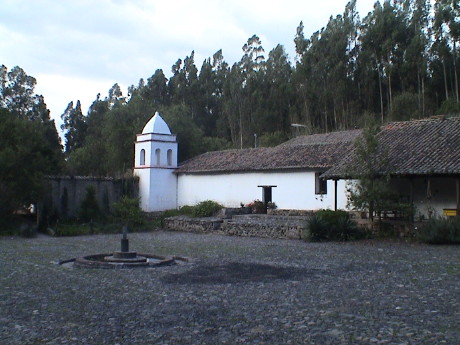 After a two hour bus ride
on good roads, we made it to the Hacienda Guachala in Pambamarca
Ecuador. The Hacienda is a 500 year old Spanish structure that has been
converted to a resort hotel. It is rated four or five stars on the
Ecuador system, but it is a little rustic by normal five star
standards.
After a two hour bus ride
on good roads, we made it to the Hacienda Guachala in Pambamarca
Ecuador. The Hacienda is a 500 year old Spanish structure that has been
converted to a resort hotel. It is rated four or five stars on the
Ecuador system, but it is a little rustic by normal five star
standards.
Quito is on a shelf on the east side of the costal volcanic mountain
range. To it's east is the Quito Basin that has a deep river gorge in
the middle running north and south. East of that, on the other side of
the basin is Pambamarca. Further east are more ranges of the Andes and
then the Amazon. The nearest large town, Cayambe, is the provincial
capital. The gentleman that owns this Hacienda is the Governor of the
province.
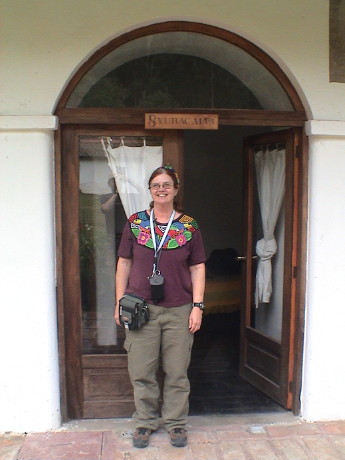 Our room is
actually in a stable which has been converted to a hotel room. It is
basic, but nice. We have a double bed, a desk, a bathroom and a
heater.
Our room is
actually in a stable which has been converted to a hotel room. It is
basic, but nice. We have a double bed, a desk, a bathroom and a
heater.
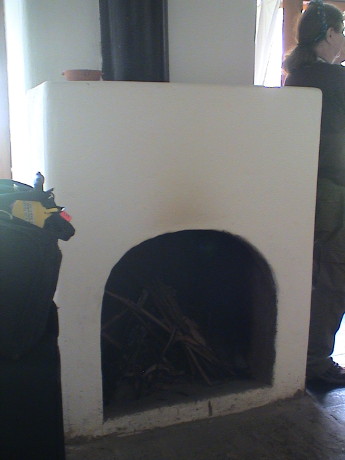 The
heater, however, is wood burning. There is plenty of eucalyptus wood,
bark and leaves to start and fuel the fire.
The
heater, however, is wood burning. There is plenty of eucalyptus wood,
bark and leaves to start and fuel the fire.
We got here about 1300 and made sandwiches for lunch from materials
provided. The afternoon was consumed by staff meetings and student
meetings. I got staff assignments as "Technician" and "Mr. Fix It." I
will help set up the computer lab and keep it going along with, at
least trying, to fix things that break.
The Hacienda has wireless internet in the lounge/library/game room
but it is not free. We got 3 hours for some undetermined rate but it is
probably pretty low, we think about $8. Email and web pages will be
checked and updated on an a time available basis, but it looks like the
schedules will not provide a whole lot of free time.
We get breakfast and dinner prepared by the Hacienda kitchen. Our
first dinner was some excellently prepared soup, chicken, rice and
potatoes. We make our own lunches from materials provided to take with
us into the field.
Tomorrow will be a conditioning hike up to Quitoloma. This is one of
the largest fort complexes with about 100 buildings in it. We are told
that it is a pretty good hike. The rest of the first week will be a
combination of classes for the students and some field work. The last 4
weeks are mostly field work.
Monday, June 22, 2009, Hacienda Guachala, Ecuador, about 1600 ECT
(GMT -6)
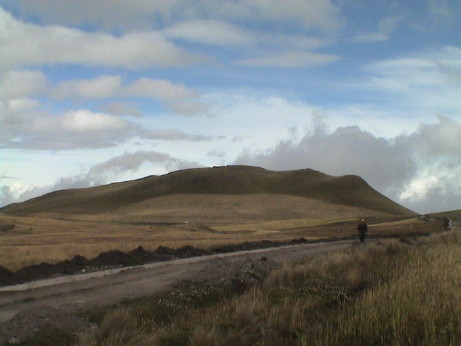 This was our destination for
today, Quitoloma, a fortified hill with about 100 Inca structures on
top within defensive walls that barely show up as rings around the hill
in the photo. The altitude was higher than we expected. While we were
there, I estimated the altitude at about 11,000 ft. According to a
topographical map, the peak is 3781 meters or 12,401 ft high. Our climb
was about 140 meters or 449 ft. The trail is fairly steep and it is a
stiff climb and any altitude, a real chug at 12,000+ ft.
This was our destination for
today, Quitoloma, a fortified hill with about 100 Inca structures on
top within defensive walls that barely show up as rings around the hill
in the photo. The altitude was higher than we expected. While we were
there, I estimated the altitude at about 11,000 ft. According to a
topographical map, the peak is 3781 meters or 12,401 ft high. Our climb
was about 140 meters or 449 ft. The trail is fairly steep and it is a
stiff climb and any altitude, a real chug at 12,000+ ft.
The area around Quitoloma is dotted with small farms. It is tough
going to make a productive farm at this altitude although the soil is
pretty good. The major crops are potatoes and onions.
The weather was also variable. The project instructed us to dress in
layers, which we did. There were times when I had everything on and
other times where I took off all what I could. We got rained on a
little on the way down. The wind wasn't a factor today, but it could
easily be on other days. Most of the farm houses that we could see were
built into the earth somewhat, probably for wind protection.
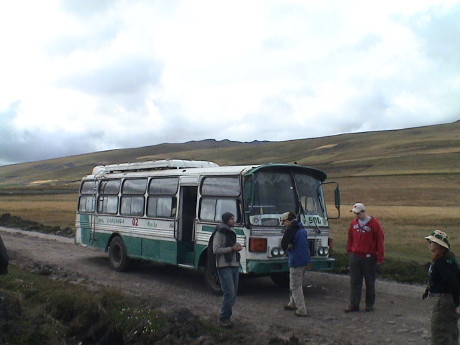 We got there on a typical
bus for this region. The bus has a Mercedes Benz diesel engine of which
the driver is very proud. It has to be tough to handle the steep roads
in this area.
We got there on a typical
bus for this region. The bus has a Mercedes Benz diesel engine of which
the driver is very proud. It has to be tough to handle the steep roads
in this area.
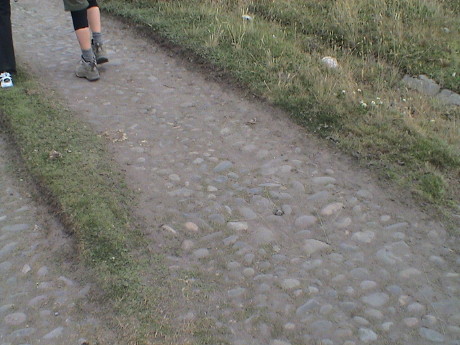 Speaking of the
roads, most are cobblestone. They appear to be durable, are built of
local materials and use local labor. This is a good stretch, most of
them have a poured concrete drainage ditch on both sides. Some
stretches of road were just dirt with heavy ruts and other
obstructions. In the bad stretches, our speed was maybe 5 to 10 mph. In
the little town of Cangahua, about 2 miles up the road from the
Hacienda, the road is well paved with concrete paving stones. The
largest part of the PAP students and staff are staying in Cangahua.
Speaking of the
roads, most are cobblestone. They appear to be durable, are built of
local materials and use local labor. This is a good stretch, most of
them have a poured concrete drainage ditch on both sides. Some
stretches of road were just dirt with heavy ruts and other
obstructions. In the bad stretches, our speed was maybe 5 to 10 mph. In
the little town of Cangahua, about 2 miles up the road from the
Hacienda, the road is well paved with concrete paving stones. The
largest part of the PAP students and staff are staying in Cangahua.
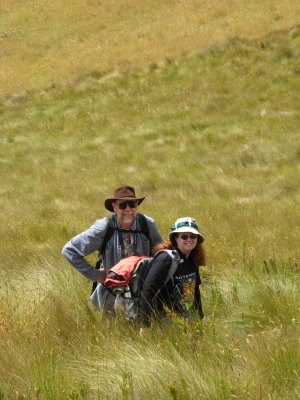 This is a picture
taken by Chad as Sandy and I were climbing Quitoloma. The whole project
gallery that this picture was taken from is part of a PAP slide
show.
This is a picture
taken by Chad as Sandy and I were climbing Quitoloma. The whole project
gallery that this picture was taken from is part of a PAP slide
show.
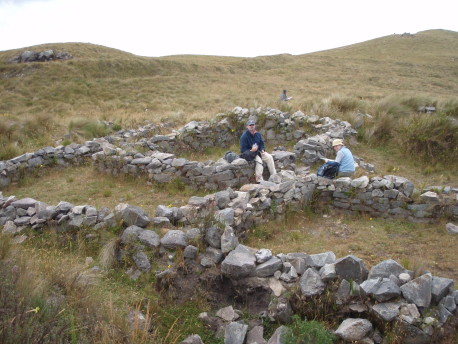 The ruins of the Inca structures
dot the whole top of the mountain. This was apparently a fairly
important fort because of it's size. Most of the structures are smaller
than this one and many are fully concealed in the long grasses that
grow in the area. The exact purpose of each of these structures is
still unknown, that is one thing that the PAP project is trying to
figure out.
The ruins of the Inca structures
dot the whole top of the mountain. This was apparently a fairly
important fort because of it's size. Most of the structures are smaller
than this one and many are fully concealed in the long grasses that
grow in the area. The exact purpose of each of these structures is
still unknown, that is one thing that the PAP project is trying to
figure out.
By the time that we got down the hill and back to the bus, Sandy and
I were pretty tired. However, a large group of the students and staff
elected to hike back, a considerable distance. They are probably in for
a 4 hour hike. We wouldn't have made it.
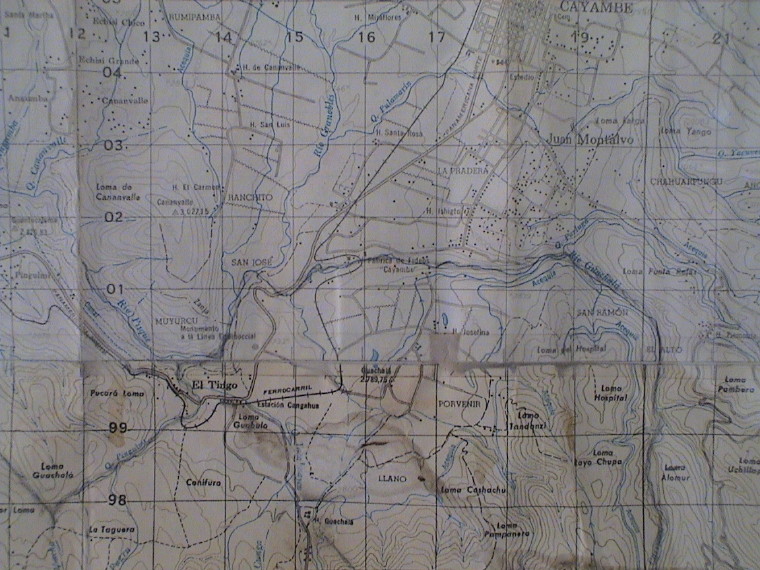 I found a topographical
map hanging on the wall of a church converted to a museum at the
Hacienda. The largest town in the area is Cayambe at the upper right.
For reference, Cayambe also shows on the Google Maps image at the top
of this page. The Hacienda is just north of Guachala. The town called
Guachala is located at the intersection of 98 on the vertical scale and
15 on the horizontal scale. I believe that these numbers represent
kilometers. This is an old map, as of 1996, the town is named Buena
Esperanza.
I found a topographical
map hanging on the wall of a church converted to a museum at the
Hacienda. The largest town in the area is Cayambe at the upper right.
For reference, Cayambe also shows on the Google Maps image at the top
of this page. The Hacienda is just north of Guachala. The town called
Guachala is located at the intersection of 98 on the vertical scale and
15 on the horizontal scale. I believe that these numbers represent
kilometers. This is an old map, as of 1996, the town is named Buena
Esperanza.
The Hacienda is just south of the equator by only 1 minute 30
seconds of a degree as measured on Sandy's GPS. The equator shows on
the map at the 00 point on the scale at the left.
Tuesday, June 23, 2009, Hacienda Guachala, Ecuador, about 1630 ECT
(GMT -6)
Today was our first real work day. An experienced staff member,
Barry, and I were assigned to lead a team of four students on a real
dig. The dig site is called Molinoloma which is located right up the
hill behind the Hacienda. It was a pretty steep climb getting there.
This site is undergoing continuing excavation. The archaeologist, Eric,
leading this dig isn't completely sure what this site was, but it was
probably a storehouse complex for either the Inca or local tribes. The
Inca would tax the occupants of the areas that they conquered in the
form of goods, corn, textiles, sandals, baskets, or whatever those
people could provide. The loot would be stored in warehouses. In bad
times, the Inca would also redistribute this stuff back to the local
people and then refresh it with new stock when times were better.
There isn't much left of the structures besides stone walls and
floors that are all buried. It is believed that the structures were
built of adobe, some wood and thatch above the level of the stone
foundations. The Spanish may have looted these warehouses and burned
them to deprive the Inca of this material during their conquest of the
Inca. Alternately, the Inca themselves may have burned them in retreat
from the Spanish to deprive the Spanish of the contents.
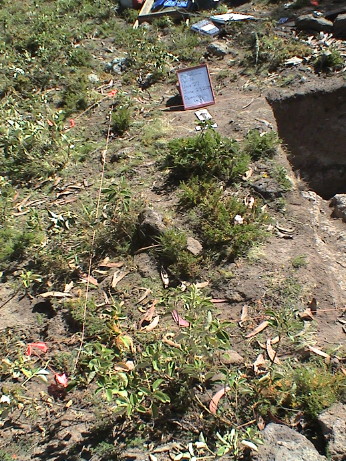 Our
team's dig is a "unit" 1 meter long by 2 meters wide extending the edge
of a previous dig. A unit is a single dig project of varying size.
There is what appears to be a drainage trench leading in from the right
heading downhill. This trench appears to be placed between two
structures. Eric wants to know how far the trench goes so we're digging
to find out. The unit is marked off with colored string tied to large
nails driven into the ground. Once the edges are dug to define the
workspace, the nails and marker string can be removed.
Our
team's dig is a "unit" 1 meter long by 2 meters wide extending the edge
of a previous dig. A unit is a single dig project of varying size.
There is what appears to be a drainage trench leading in from the right
heading downhill. This trench appears to be placed between two
structures. Eric wants to know how far the trench goes so we're digging
to find out. The unit is marked off with colored string tied to large
nails driven into the ground. Once the edges are dug to define the
workspace, the nails and marker string can be removed.
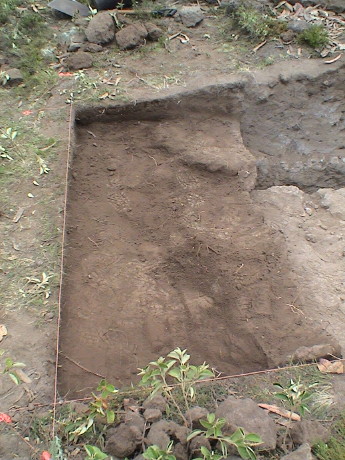 We started
digging about 1000 and worked to about 1530. It rained around
lunchtime, we worked on through the rain. Thunder and lightening were
threatening at about quitting time. This photos shows as far as we got.
In the excavated material we found three small pot shards and some
other small nodules that need analysis to determine what they were. We
are working outside of a structure so we don't expect to find much in
the way of artifacts. Eric is looking for some kernels of burnt corn
that could reinforce his postulate that these were storehouses.
We started
digging about 1000 and worked to about 1530. It rained around
lunchtime, we worked on through the rain. Thunder and lightening were
threatening at about quitting time. This photos shows as far as we got.
In the excavated material we found three small pot shards and some
other small nodules that need analysis to determine what they were. We
are working outside of a structure so we don't expect to find much in
the way of artifacts. Eric is looking for some kernels of burnt corn
that could reinforce his postulate that these were storehouses.
After we got back to the Hacienda, we put away our tools and Sandy
crashed. I took a few minutes to download my photos and update this
diary. Some of the other students are taking the bus (a $0.25 fare) to
Cayambe to look for stuff that they didn't bring. Sandy and I were
pretty well prepared as we had stocked up at the Supermaxi in Quito so
we won't have to buy stuff for some time.
Wednesday, June 24, 2009, Hacienda Guachala, Ecuador, about 1620
ECT (GMT -6)
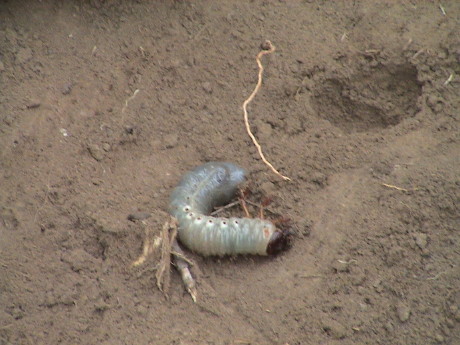 Today was
a continuation of the work on Molinoloma. Sandy was reassigned to open
another unit. While she was digging, this grub crawled out of a hole
she exposed. This puppy is about 10 cm (4") long. It was identified by
someone that knew what it was as a scorpion larvae. This place is
crawling with scorpions although I haven't seen a live one yet I have
run across several dead ones.
Today was
a continuation of the work on Molinoloma. Sandy was reassigned to open
another unit. While she was digging, this grub crawled out of a hole
she exposed. This puppy is about 10 cm (4") long. It was identified by
someone that knew what it was as a scorpion larvae. This place is
crawling with scorpions although I haven't seen a live one yet I have
run across several dead ones.
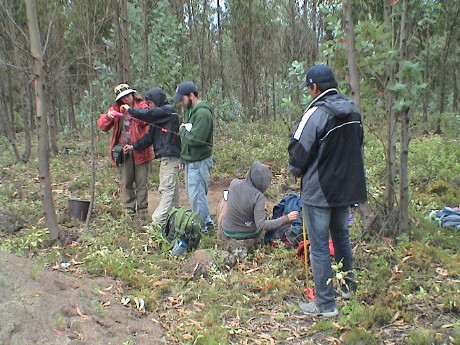 Later in
the day, Sandy's new unit was closed. The unit was opened down the hill
a little ways to see if there were any more structures down there. They
hit hardpan very quickly so that it was clear that there was nothing
buried there. Sandy and the other students are doing the closing
measurements to record the results of their excavation.
Later in
the day, Sandy's new unit was closed. The unit was opened down the hill
a little ways to see if there were any more structures down there. They
hit hardpan very quickly so that it was clear that there was nothing
buried there. Sandy and the other students are doing the closing
measurements to record the results of their excavation.
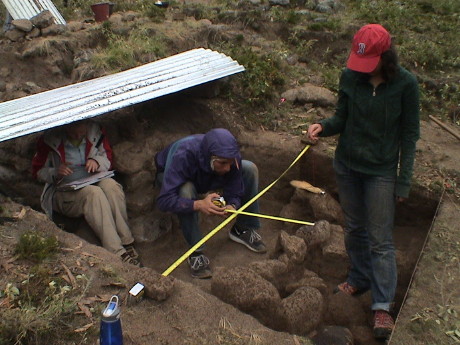 This is the unit
that I am working on near the end of the 2nd day. The students are
doing a map of the positions, sizes, and types of rocks before they are
removed to allow us to excavate deeper. The photo seems a little dark,
because it was dark, it was also raining. That is why the galvanized
steel sheet is bridged across the site to shield the map maker from the
rain so that the drawing doesn't get damaged. The other two students
are measuring the XY position of the rocks. For this map, the depth of
the rocks isn't important.
This is the unit
that I am working on near the end of the 2nd day. The students are
doing a map of the positions, sizes, and types of rocks before they are
removed to allow us to excavate deeper. The photo seems a little dark,
because it was dark, it was also raining. That is why the galvanized
steel sheet is bridged across the site to shield the map maker from the
rain so that the drawing doesn't get damaged. The other two students
are measuring the XY position of the rocks. For this map, the depth of
the rocks isn't important.
There doesn't seem to be an obvious pattern to the rocks so that
they are probably there from a fallen nearby wall. Three of the largest
stones were river rocks, they didn't get here on a hilltop by
themselves. Tomorrow, we'll finish the map, remove the rocks and start
going deeper.
We did find a few more pottery shards and a very nice, although
small obsidian flake that had pretty clearly been shaped to form a
small tool before we were stopped by the rocks.
After a couple of nights here, we've found that it is cold but not
as cold as it was billed to be. There are plenty of blankets and the
fireplace does a credible job of keeping the place warm.
Our routine for the first week is to wake at 0630, prepare our own
lunches starting at about 0700 when the lunch room is opened, get
breakfast at about 0730 and meet in the lab to collect our gear at
0800. By 0830 or 0900, we are at the work site preparing to start for
the day. We knock off work at 1500 and clean up all of our tools and
trek down the hill at about 1530.
Breakfast has been variable, fruit and eggs one day, fruit the next
and home made granola the next. A local cheese, juice made from local
fruits and berries, bread, coffee and yogurt are available every
day.
Dinner has been variable too. We've had excellent chicken, pizza,
and some kind of veggie pattie that REALLY need the hot sauce that I
brought. There is soup and desert with each meal. Nothing has been
repeated yet and the food has generally been very good.
Thursday, June 25, 2009, Hacienda Guachala, Ecuador, about 1630 ECT
(GMT -6)
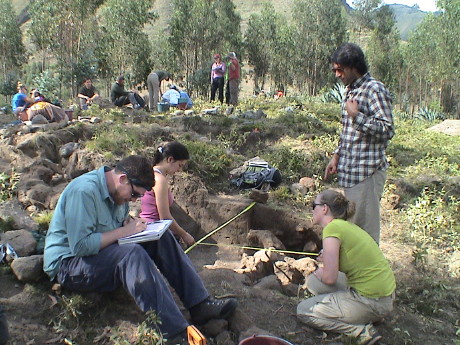 Today, we hiked back up to Molinoloma for our 3rd day of excavation of
unit 27. This is the student team doing the final mapping of the rocks
that we uncovered. From left to right, they are Scott, Hannah, Marsha
and Gabriel. Due to their random orientation, these rocks are probably
"wall fall", or rocks that fell from a nearby structure wall.
Today, we hiked back up to Molinoloma for our 3rd day of excavation of
unit 27. This is the student team doing the final mapping of the rocks
that we uncovered. From left to right, they are Scott, Hannah, Marsha
and Gabriel. Due to their random orientation, these rocks are probably
"wall fall", or rocks that fell from a nearby structure wall.
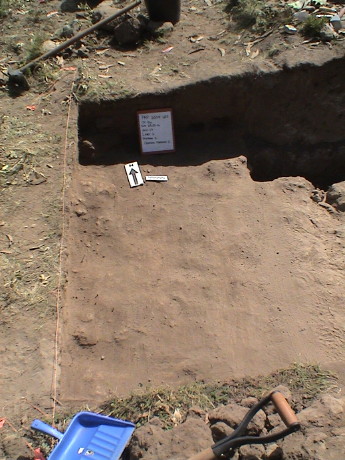 It took about 30 minutes to finish the map. Then we removed the rocks
and leveled the dirt that was left to the same level as where the
adjacent excavation of unit 23 had finished last year. After the rocks
and more dirt were cleared, this is what it looked like. Last year's
team said that they had stopped at a layer of bedrock, but it seemed
pretty soft. Our surface seemed soft too. Then the unit was subdivided.
The north 20% of the unit was designated as a "feature" and handled
separately from the rest of the unit. This is where the trench that
came down from unit 23 seemed to go. All the dirt taken from this part
was carried back down the hill for floatation analysis to look for
seeds and other light materials. All of the dirt that had been removed
before had been sifted through a 4 mesh (1/4" hardware cloth) screen to
look for artifacts hidden in the dirt. In the previous two days we'd
found lots of pot shards, a few items that looked like burnt seeds and
a piece of obsidian that had been shaped for use as a tool.
It took about 30 minutes to finish the map. Then we removed the rocks
and leveled the dirt that was left to the same level as where the
adjacent excavation of unit 23 had finished last year. After the rocks
and more dirt were cleared, this is what it looked like. Last year's
team said that they had stopped at a layer of bedrock, but it seemed
pretty soft. Our surface seemed soft too. Then the unit was subdivided.
The north 20% of the unit was designated as a "feature" and handled
separately from the rest of the unit. This is where the trench that
came down from unit 23 seemed to go. All the dirt taken from this part
was carried back down the hill for floatation analysis to look for
seeds and other light materials. All of the dirt that had been removed
before had been sifted through a 4 mesh (1/4" hardware cloth) screen to
look for artifacts hidden in the dirt. In the previous two days we'd
found lots of pot shards, a few items that looked like burnt seeds and
a piece of obsidian that had been shaped for use as a tool.
 Another team
working on a nearby unit uncovered this scorpion. Shortly afterward,
they uncovered a really tiny one. These are the only two live ones that
I've seen so far but we have to be careful, they are out there.
Another team
working on a nearby unit uncovered this scorpion. Shortly afterward,
they uncovered a really tiny one. These are the only two live ones that
I've seen so far but we have to be careful, they are out there.
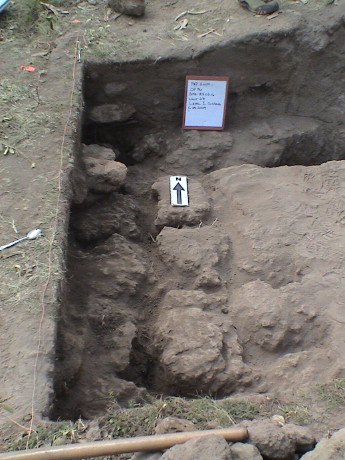 By
the end of our workday, we'd uncovered yet another layer of rough
stones, some not very thick, as little as 10 cm. Due to the alignment
of the rather large gaps between the stones, we surmise that they were
laid by hand in a rough fashion suitable for the need. However, we
don't know what that need was. At the very right edge of the photo is
the edge of unit 23. Tomorrow, we'll reopen unit 23 and clean about a
1.5 x 1 meter area. We expect that we'll find similar stones all the
way up to a built stone wall about 1 meter away from the edge of our
unit.
By
the end of our workday, we'd uncovered yet another layer of rough
stones, some not very thick, as little as 10 cm. Due to the alignment
of the rather large gaps between the stones, we surmise that they were
laid by hand in a rough fashion suitable for the need. However, we
don't know what that need was. At the very right edge of the photo is
the edge of unit 23. Tomorrow, we'll reopen unit 23 and clean about a
1.5 x 1 meter area. We expect that we'll find similar stones all the
way up to a built stone wall about 1 meter away from the edge of our
unit.
We had really nice weather up there all day today. It was mostly
clear, no rain, not very hot but breezy. The weather here is pretty
unpredictable. Tomorrow couldn't get much better, but it could be a lot
worse.
Sandy was working on two other units during the day, check out her
website for more details on
her day.
Friday, June 26, 2009, Hacienda Guachala, Ecuador, about 1940 ECT
(GMT -6)
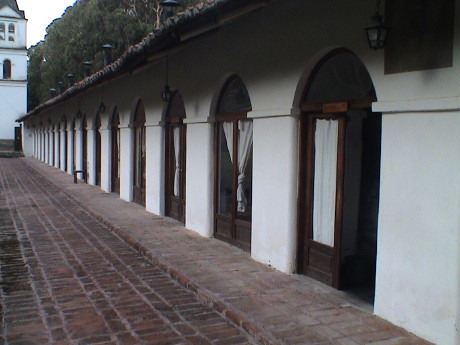 This morning as we
were doing our early rounds, I took some pictures of the Hacienda while
the lighting was subdued before the sun rose above the hills to the
east. Our room is the one on the right. These were stables that have
been converted to hotel rooms. They did a pretty good job.
This morning as we
were doing our early rounds, I took some pictures of the Hacienda while
the lighting was subdued before the sun rose above the hills to the
east. Our room is the one on the right. These were stables that have
been converted to hotel rooms. They did a pretty good job.
 This is Sandy
in our room with our luggage all piled on the single bed.
This is Sandy
in our room with our luggage all piled on the single bed.
 The original part of the
Hacienda is built around a main plaza. This view is from in front of
the chapel looking back to the restaurant and hotel office. The library
and internet center is to the left.
The original part of the
Hacienda is built around a main plaza. This view is from in front of
the chapel looking back to the restaurant and hotel office. The library
and internet center is to the left.
 The Hacienda dining
room is set up for our group of 23 on the larger table. The smaller
table is used for the other hotel guests as well as the tables
outside.
The Hacienda dining
room is set up for our group of 23 on the larger table. The smaller
table is used for the other hotel guests as well as the tables
outside.
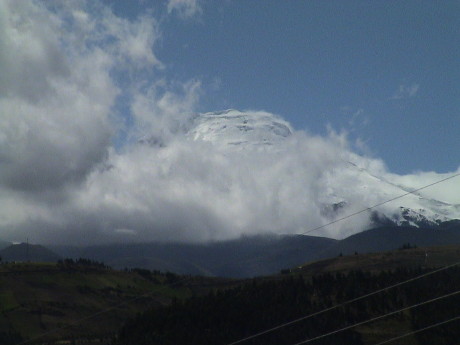 At about
0815, we left the Hacienda to hike up to the work site on Molinoloma
for the 4th day of work. For a few minutes, the clouds blew away from
Mt. Cayambe, an active volcano, so that I could see the peak and the
glacier that drapes down the side of the mountain. The mountain is
about 18,200 ft high.
At about
0815, we left the Hacienda to hike up to the work site on Molinoloma
for the 4th day of work. For a few minutes, the clouds blew away from
Mt. Cayambe, an active volcano, so that I could see the peak and the
glacier that drapes down the side of the mountain. The mountain is
about 18,200 ft high.
 Our team
didn't excavate a grain of dirt from unit 27 all day. Eric wanted
measurements before we closed the excavation and it took virtually all
day. Eric may want to reopen the unit later to see if anything is
underneath the Cangahua blocks that we uncovered, but it looks like
that we may have reached the bottom as we found no artifacts in the
last 10+ buckets of dirt that we pulled out.
Our team
didn't excavate a grain of dirt from unit 27 all day. Eric wanted
measurements before we closed the excavation and it took virtually all
day. Eric may want to reopen the unit later to see if anything is
underneath the Cangahua blocks that we uncovered, but it looks like
that we may have reached the bottom as we found no artifacts in the
last 10+ buckets of dirt that we pulled out.
Toward the end of the day, after unit 27 was closed, we opened a new
5 square meter unit, number 33, right next to unit 27. The purpose of
the unit 33 excavation is to expose a wall that appears to extend right
through the unit and to see what else we can find. Eric want's to
eventually expose this whole structure.
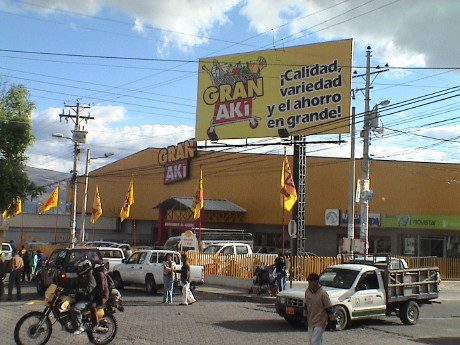 Right after we climbed
down the hill from the work site, we put away our gear and caught a bus
to the town of Cayambe about a 20 minute ride away. The bus fare is
$0.25. Our target was a supermarket and a pharmacy. At the Gran AKi
market we found some chocolate and hot sauce, both necessary
commodities. At a pharmacy about a block away we got some sunblock and
insect repellent.
Right after we climbed
down the hill from the work site, we put away our gear and caught a bus
to the town of Cayambe about a 20 minute ride away. The bus fare is
$0.25. Our target was a supermarket and a pharmacy. At the Gran AKi
market we found some chocolate and hot sauce, both necessary
commodities. At a pharmacy about a block away we got some sunblock and
insect repellent.
 The bus station
had a banos (bathroom). It costs 5 cents to use, and another 10 cents
if you want some paper. The bus ride back was really crowed, we had a
seat but had to get up and work our way up the isle near our stop at
the Hacienda to tell the driver that we wanted a stop. We did make it
back in time for dinner where I was able to try out the three hot
sauces that I bought. One in particular was VERY good, Chipotle Gold,
made in Quito. We plan to buy several bottles to bring home the next
time we make it back there.
The bus station
had a banos (bathroom). It costs 5 cents to use, and another 10 cents
if you want some paper. The bus ride back was really crowed, we had a
seat but had to get up and work our way up the isle near our stop at
the Hacienda to tell the driver that we wanted a stop. We did make it
back in time for dinner where I was able to try out the three hot
sauces that I bought. One in particular was VERY good, Chipotle Gold,
made in Quito. We plan to buy several bottles to bring home the next
time we make it back there.
Saturday, June 27, 2009, Hacienda Guachala, Ecuador, about 1700 ECT
(GMT -6)
 For the next two weeks, a
local festival will be celebrated all over the area. I don't know what
the festival is about, but it will impact us. The hotel is all decked
out in signs, there are tents set up in the plaza, there are lots of
people about and food and drink being served in large quantities. A
large field outside has been converted into a horse race track. There
are new vehicles and tractors parked outside and the pasture on the
south side that used to have a few horses in it is now an overflow
parking lot because the regular dirt parking area is filled with cars.
We don't have the run of the place like we did before while we were
about the only guests here.
For the next two weeks, a
local festival will be celebrated all over the area. I don't know what
the festival is about, but it will impact us. The hotel is all decked
out in signs, there are tents set up in the plaza, there are lots of
people about and food and drink being served in large quantities. A
large field outside has been converted into a horse race track. There
are new vehicles and tractors parked outside and the pasture on the
south side that used to have a few horses in it is now an overflow
parking lot because the regular dirt parking area is filled with cars.
We don't have the run of the place like we did before while we were
about the only guests here.
We saw a truckload of eucalyptus branches being hauled in earlier.
There were dumped in a large pile in the north half of the plaza. The
tents are in the south half. As we left the library after uploading our
web pages last night, the pile had just been ignited. At times, the
flames were much higher than the photo shows. There were glowing embers
blowing into the garden area to the north of the plaza and the heat was
so great that we couldn't get by the fire to make it to the paths to
our room. We just rested on a bench against the chapel and waited until
the fire burned down a little such that we could get by without being
scorched.
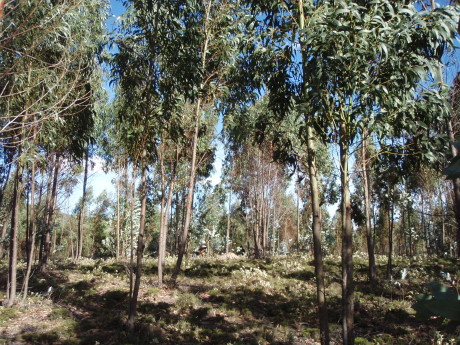 At 0800 on
Saturday, June 27, we picked up our tools and hiked back up to
Molinoloma. The site is set in a eucalyptus forest. This is actually a
plantation as the trees are planted in rows all around the work
site.
At 0800 on
Saturday, June 27, we picked up our tools and hiked back up to
Molinoloma. The site is set in a eucalyptus forest. This is actually a
plantation as the trees are planted in rows all around the work
site.
Our days have settled into a routine. The alarm goes off at 0630. By
0700, we are at the lunch room to make our lunches. At 0730 the dining
room opens for breakfast. We have only about 15 minutes for breakfast
as we need to be at the lab by about 0745 for morning announcements and
to pick up our tools. By 0800, we leave for the hike up the mountain
which takes 20 minutes or so. We then set up to continue with the
excavation of the site. We break for lunch at about 1200 and are back
to work at 1230. Between 1500 and 1530, we stop work, gather our tools
and head down the hill. By about 1600, we've put our tools away and
cleaned up. The time between 1600 and 1830 is our "free" time. Last
night, we took the bus into Cayambe but most nights we rest and write
up our day on these pages. Dinner is at 1830 and for this week anyway,
there has been a lecture at about 1930 or 2000 for about an hour. After
returning to our room, I shower to clean off the grime from the day and
I'm ready for bed.
This will all change somewhat next week as some students will be
split off to go to work sites other than Molinoloma. Some of these are
at much higher altitude and require a bus ride and a lot more climbing
to reach.
The last two days and nights have been very windy so we had big
problems with blowing dust from the sifting of the dirt dug from the
units. This was actually preferable to the previous 3 days were it was
still and even rainy. The wind was not constant, but got up to
something less than 30 knots. The wind blew away all the biting flies
that were on the site this year. These little things are similar to
northern black flies. They swoop in, hack off a piece of flesh and
leave. The resulting wound results in a persistent red and painful
welt. They could find the smallest piece of exposed skin that wasn't
covered in insect repellant. I even got some up my pants leg and it or
they chewed up my right shin.
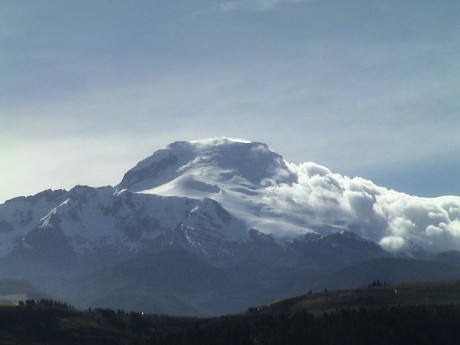 Mt. Cayambe
was even more visible today. According to Eric, this is as clear as it
gets. There are a couple of Scottish guests at the hotel that climbed
the mountain yesterday up to the level of the glacier which is still
pretty high. These folks were older than I am and I wouldn't try
that.
Mt. Cayambe
was even more visible today. According to Eric, this is as clear as it
gets. There are a couple of Scottish guests at the hotel that climbed
the mountain yesterday up to the level of the glacier which is still
pretty high. These folks were older than I am and I wouldn't try
that.
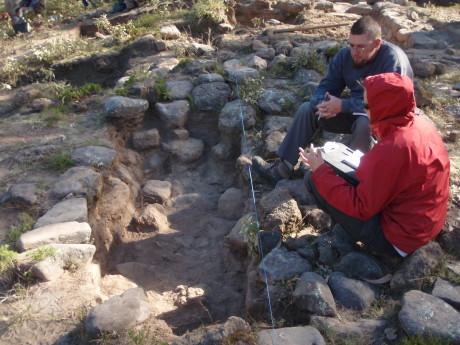 Eric and
Alli are discussing the day's plan for unit 21 which Sandy is working
on. This was a bowl shaped depression in the ground more or less
covered in river rock. They are sitting on the non-excavated part. It
is beginning to look like it is yet another structure as a vertical
wall three stones high is showing on the left side.
Eric and
Alli are discussing the day's plan for unit 21 which Sandy is working
on. This was a bowl shaped depression in the ground more or less
covered in river rock. They are sitting on the non-excavated part. It
is beginning to look like it is yet another structure as a vertical
wall three stones high is showing on the left side.
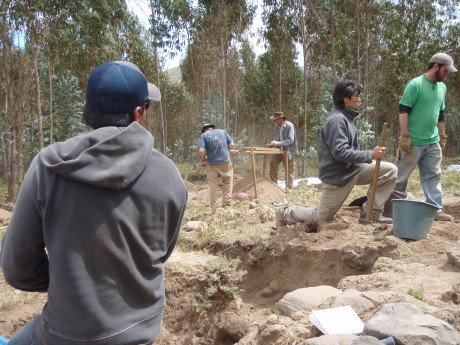 This
is a view of Scott and I sifting a bucket full of dirt from the
beginnings of the excavation of unit 33. This was a patch of dirt
between two other units this morning. All of the dirt excavated from a
unit is carried in a plastic bucket to the screen and sifted to look
for artifacts. Since most of the loose artifacts are small, virtually
all of them are found by sifting. We found pieces of pottery, some
small pieces of obsidian and a strange conglomeration of pumice. These
pieces were found both inside and outside the new wall section. Sifting
can be tedious work as most buckets have nothing interesting in them at
all. Each unit's excavated dirt is sifted into separate piles just in
case it might be necessary to resift the result. At least then it can
be determined which unit the resifted artifact came from.
This
is a view of Scott and I sifting a bucket full of dirt from the
beginnings of the excavation of unit 33. This was a patch of dirt
between two other units this morning. All of the dirt excavated from a
unit is carried in a plastic bucket to the screen and sifted to look
for artifacts. Since most of the loose artifacts are small, virtually
all of them are found by sifting. We found pieces of pottery, some
small pieces of obsidian and a strange conglomeration of pumice. These
pieces were found both inside and outside the new wall section. Sifting
can be tedious work as most buckets have nothing interesting in them at
all. Each unit's excavated dirt is sifted into separate piles just in
case it might be necessary to resift the result. At least then it can
be determined which unit the resifted artifact came from.
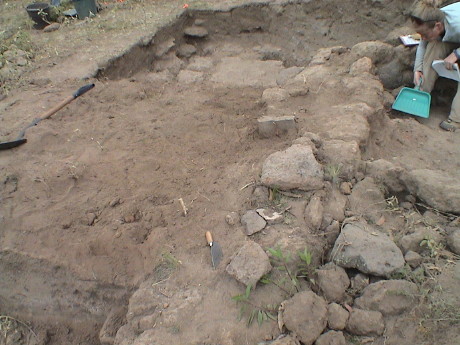 By
the time we quit today, a part of a wall had been uncovered where it
was expected to be. This is unit 33 as we left it on our short Saturday
work day. Even though we quit two hours earlier today, I was more
tired, dirty and beat up than on the previous days. Due to the wind,
everybody was coated in dirt. Yesterday, Hannah looked like she had
been rolling in dirt, mostly because she had. Today, it was Marsha's
turn, it looked like she was trying to get dirtier than Hannah was.
By
the time we quit today, a part of a wall had been uncovered where it
was expected to be. This is unit 33 as we left it on our short Saturday
work day. Even though we quit two hours earlier today, I was more
tired, dirty and beat up than on the previous days. Due to the wind,
everybody was coated in dirt. Yesterday, Hannah looked like she had
been rolling in dirt, mostly because she had. Today, it was Marsha's
turn, it looked like she was trying to get dirtier than Hannah was.
We'll continue the excavation of unit 33 to see if it matches the
combinations of units 23 and 27 next door.
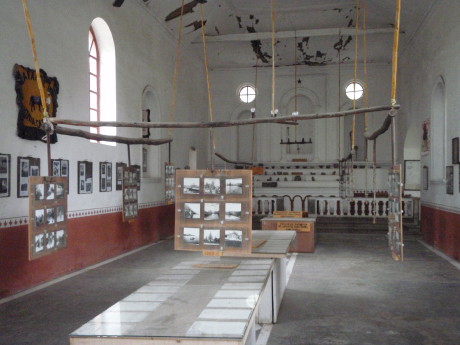 When we got back to the
Hacienda, the staff had a meeting to coordinate the arrival of the
Foothill College students tomorrow. During the meeting, Sandy was
wandering taking pictures. Many of them will show up on her page, but
this one shows the interior of the church converted to a museum. The
picture is taken from what was the main entrance looking back to the
original alter. Then we both crashed for a couple of hours to get some
much needed sleep.
When we got back to the
Hacienda, the staff had a meeting to coordinate the arrival of the
Foothill College students tomorrow. During the meeting, Sandy was
wandering taking pictures. Many of them will show up on her page, but
this one shows the interior of the church converted to a museum. The
picture is taken from what was the main entrance looking back to the
original alter. Then we both crashed for a couple of hours to get some
much needed sleep.
All the Foothill students will be staying in the Casa in Cangahua,
about 2 miles south. The Casa is actually a convent that the project
rents from the Catholic Church. The accommodations are more cramped and
less private than we have an the Hacienda, but the staff says that the
food is better. The food here is pretty good.
Tomorrow is our day off. The project was going to go on a field trip
to some hot springs over the eastern Andes and a little down the Amazon
side. However, there is a local water rights standoff going on between
the locals and the road is blocked so we have the day off. Sandy and I
will probably take the bus to Cangahua to see the festival.
[ Vacation Diaries ] [ Pambamarca 2009 ] [ Previous Page ] [ Next Page ]
© 2009 George Schreyer
Created 21 Jun 09
Last Updated June 27, 2009
 After a two hour bus ride
on good roads, we made it to the Hacienda Guachala in Pambamarca
Ecuador. The Hacienda is a 500 year old Spanish structure that has been
converted to a resort hotel. It is rated four or five stars on the
Ecuador system, but it is a little rustic by normal five star
standards.
After a two hour bus ride
on good roads, we made it to the Hacienda Guachala in Pambamarca
Ecuador. The Hacienda is a 500 year old Spanish structure that has been
converted to a resort hotel. It is rated four or five stars on the
Ecuador system, but it is a little rustic by normal five star
standards. Our room is
actually in a stable which has been converted to a hotel room. It is
basic, but nice. We have a double bed, a desk, a bathroom and a
heater.
Our room is
actually in a stable which has been converted to a hotel room. It is
basic, but nice. We have a double bed, a desk, a bathroom and a
heater. The
heater, however, is wood burning. There is plenty of eucalyptus wood,
bark and leaves to start and fuel the fire.
The
heater, however, is wood burning. There is plenty of eucalyptus wood,
bark and leaves to start and fuel the fire. This was our destination for
today, Quitoloma, a fortified hill with about 100 Inca structures on
top within defensive walls that barely show up as rings around the hill
in the photo. The altitude was higher than we expected. While we were
there, I estimated the altitude at about 11,000 ft. According to a
topographical map, the peak is 3781 meters or 12,401 ft high. Our climb
was about 140 meters or 449 ft. The trail is fairly steep and it is a
stiff climb and any altitude, a real chug at 12,000+ ft.
This was our destination for
today, Quitoloma, a fortified hill with about 100 Inca structures on
top within defensive walls that barely show up as rings around the hill
in the photo. The altitude was higher than we expected. While we were
there, I estimated the altitude at about 11,000 ft. According to a
topographical map, the peak is 3781 meters or 12,401 ft high. Our climb
was about 140 meters or 449 ft. The trail is fairly steep and it is a
stiff climb and any altitude, a real chug at 12,000+ ft. We got there on a typical
bus for this region. The bus has a Mercedes Benz diesel engine of which
the driver is very proud. It has to be tough to handle the steep roads
in this area.
We got there on a typical
bus for this region. The bus has a Mercedes Benz diesel engine of which
the driver is very proud. It has to be tough to handle the steep roads
in this area. Speaking of the
roads, most are cobblestone. They appear to be durable, are built of
local materials and use local labor. This is a good stretch, most of
them have a poured concrete drainage ditch on both sides. Some
stretches of road were just dirt with heavy ruts and other
obstructions. In the bad stretches, our speed was maybe 5 to 10 mph. In
the little town of Cangahua, about 2 miles up the road from the
Hacienda, the road is well paved with concrete paving stones. The
largest part of the PAP students and staff are staying in Cangahua.
Speaking of the
roads, most are cobblestone. They appear to be durable, are built of
local materials and use local labor. This is a good stretch, most of
them have a poured concrete drainage ditch on both sides. Some
stretches of road were just dirt with heavy ruts and other
obstructions. In the bad stretches, our speed was maybe 5 to 10 mph. In
the little town of Cangahua, about 2 miles up the road from the
Hacienda, the road is well paved with concrete paving stones. The
largest part of the PAP students and staff are staying in Cangahua. This is a picture
taken by Chad as Sandy and I were climbing Quitoloma. The whole project
gallery that this picture was taken from is part of a
This is a picture
taken by Chad as Sandy and I were climbing Quitoloma. The whole project
gallery that this picture was taken from is part of a  The ruins of the Inca structures
dot the whole top of the mountain. This was apparently a fairly
important fort because of it's size. Most of the structures are smaller
than this one and many are fully concealed in the long grasses that
grow in the area. The exact purpose of each of these structures is
still unknown, that is one thing that the PAP project is trying to
figure out.
The ruins of the Inca structures
dot the whole top of the mountain. This was apparently a fairly
important fort because of it's size. Most of the structures are smaller
than this one and many are fully concealed in the long grasses that
grow in the area. The exact purpose of each of these structures is
still unknown, that is one thing that the PAP project is trying to
figure out. I found a topographical
map hanging on the wall of a church converted to a museum at the
Hacienda. The largest town in the area is Cayambe at the upper right.
For reference, Cayambe also shows on the Google Maps image at the top
of this page. The Hacienda is just north of Guachala. The town called
Guachala is located at the intersection of 98 on the vertical scale and
15 on the horizontal scale. I believe that these numbers represent
kilometers. This is an old map, as of 1996, the town is named Buena
Esperanza.
I found a topographical
map hanging on the wall of a church converted to a museum at the
Hacienda. The largest town in the area is Cayambe at the upper right.
For reference, Cayambe also shows on the Google Maps image at the top
of this page. The Hacienda is just north of Guachala. The town called
Guachala is located at the intersection of 98 on the vertical scale and
15 on the horizontal scale. I believe that these numbers represent
kilometers. This is an old map, as of 1996, the town is named Buena
Esperanza. Our
team's dig is a "unit" 1 meter long by 2 meters wide extending the edge
of a previous dig. A unit is a single dig project of varying size.
There is what appears to be a drainage trench leading in from the right
heading downhill. This trench appears to be placed between two
structures. Eric wants to know how far the trench goes so we're digging
to find out. The unit is marked off with colored string tied to large
nails driven into the ground. Once the edges are dug to define the
workspace, the nails and marker string can be removed.
Our
team's dig is a "unit" 1 meter long by 2 meters wide extending the edge
of a previous dig. A unit is a single dig project of varying size.
There is what appears to be a drainage trench leading in from the right
heading downhill. This trench appears to be placed between two
structures. Eric wants to know how far the trench goes so we're digging
to find out. The unit is marked off with colored string tied to large
nails driven into the ground. Once the edges are dug to define the
workspace, the nails and marker string can be removed. We started
digging about 1000 and worked to about 1530. It rained around
lunchtime, we worked on through the rain. Thunder and lightening were
threatening at about quitting time. This photos shows as far as we got.
In the excavated material we found three small pot shards and some
other small nodules that need analysis to determine what they were. We
are working outside of a structure so we don't expect to find much in
the way of artifacts. Eric is looking for some kernels of burnt corn
that could reinforce his postulate that these were storehouses.
We started
digging about 1000 and worked to about 1530. It rained around
lunchtime, we worked on through the rain. Thunder and lightening were
threatening at about quitting time. This photos shows as far as we got.
In the excavated material we found three small pot shards and some
other small nodules that need analysis to determine what they were. We
are working outside of a structure so we don't expect to find much in
the way of artifacts. Eric is looking for some kernels of burnt corn
that could reinforce his postulate that these were storehouses. Today was
a continuation of the work on Molinoloma. Sandy was reassigned to open
another unit. While she was digging, this grub crawled out of a hole
she exposed. This puppy is about 10 cm (4") long. It was identified by
someone that knew what it was as a scorpion larvae. This place is
crawling with scorpions although I haven't seen a live one yet I have
run across several dead ones.
Today was
a continuation of the work on Molinoloma. Sandy was reassigned to open
another unit. While she was digging, this grub crawled out of a hole
she exposed. This puppy is about 10 cm (4") long. It was identified by
someone that knew what it was as a scorpion larvae. This place is
crawling with scorpions although I haven't seen a live one yet I have
run across several dead ones. Later in
the day, Sandy's new unit was closed. The unit was opened down the hill
a little ways to see if there were any more structures down there. They
hit hardpan very quickly so that it was clear that there was nothing
buried there. Sandy and the other students are doing the closing
measurements to record the results of their excavation.
Later in
the day, Sandy's new unit was closed. The unit was opened down the hill
a little ways to see if there were any more structures down there. They
hit hardpan very quickly so that it was clear that there was nothing
buried there. Sandy and the other students are doing the closing
measurements to record the results of their excavation. This is the unit
that I am working on near the end of the 2nd day. The students are
doing a map of the positions, sizes, and types of rocks before they are
removed to allow us to excavate deeper. The photo seems a little dark,
because it was dark, it was also raining. That is why the galvanized
steel sheet is bridged across the site to shield the map maker from the
rain so that the drawing doesn't get damaged. The other two students
are measuring the XY position of the rocks. For this map, the depth of
the rocks isn't important.
This is the unit
that I am working on near the end of the 2nd day. The students are
doing a map of the positions, sizes, and types of rocks before they are
removed to allow us to excavate deeper. The photo seems a little dark,
because it was dark, it was also raining. That is why the galvanized
steel sheet is bridged across the site to shield the map maker from the
rain so that the drawing doesn't get damaged. The other two students
are measuring the XY position of the rocks. For this map, the depth of
the rocks isn't important. Today, we hiked back up to Molinoloma for our 3rd day of excavation of
unit 27. This is the student team doing the final mapping of the rocks
that we uncovered. From left to right, they are Scott, Hannah, Marsha
and Gabriel. Due to their random orientation, these rocks are probably
"wall fall", or rocks that fell from a nearby structure wall.
Today, we hiked back up to Molinoloma for our 3rd day of excavation of
unit 27. This is the student team doing the final mapping of the rocks
that we uncovered. From left to right, they are Scott, Hannah, Marsha
and Gabriel. Due to their random orientation, these rocks are probably
"wall fall", or rocks that fell from a nearby structure wall. It took about 30 minutes to finish the map. Then we removed the rocks
and leveled the dirt that was left to the same level as where the
adjacent excavation of unit 23 had finished last year. After the rocks
and more dirt were cleared, this is what it looked like. Last year's
team said that they had stopped at a layer of bedrock, but it seemed
pretty soft. Our surface seemed soft too. Then the unit was subdivided.
The north 20% of the unit was designated as a "feature" and handled
separately from the rest of the unit. This is where the trench that
came down from unit 23 seemed to go. All the dirt taken from this part
was carried back down the hill for floatation analysis to look for
seeds and other light materials. All of the dirt that had been removed
before had been sifted through a 4 mesh (1/4" hardware cloth) screen to
look for artifacts hidden in the dirt. In the previous two days we'd
found lots of pot shards, a few items that looked like burnt seeds and
a piece of obsidian that had been shaped for use as a tool.
It took about 30 minutes to finish the map. Then we removed the rocks
and leveled the dirt that was left to the same level as where the
adjacent excavation of unit 23 had finished last year. After the rocks
and more dirt were cleared, this is what it looked like. Last year's
team said that they had stopped at a layer of bedrock, but it seemed
pretty soft. Our surface seemed soft too. Then the unit was subdivided.
The north 20% of the unit was designated as a "feature" and handled
separately from the rest of the unit. This is where the trench that
came down from unit 23 seemed to go. All the dirt taken from this part
was carried back down the hill for floatation analysis to look for
seeds and other light materials. All of the dirt that had been removed
before had been sifted through a 4 mesh (1/4" hardware cloth) screen to
look for artifacts hidden in the dirt. In the previous two days we'd
found lots of pot shards, a few items that looked like burnt seeds and
a piece of obsidian that had been shaped for use as a tool. Another team
working on a nearby unit uncovered this scorpion. Shortly afterward,
they uncovered a really tiny one. These are the only two live ones that
I've seen so far but we have to be careful, they are out there.
Another team
working on a nearby unit uncovered this scorpion. Shortly afterward,
they uncovered a really tiny one. These are the only two live ones that
I've seen so far but we have to be careful, they are out there. By
the end of our workday, we'd uncovered yet another layer of rough
stones, some not very thick, as little as 10 cm. Due to the alignment
of the rather large gaps between the stones, we surmise that they were
laid by hand in a rough fashion suitable for the need. However, we
don't know what that need was. At the very right edge of the photo is
the edge of unit 23. Tomorrow, we'll reopen unit 23 and clean about a
1.5 x 1 meter area. We expect that we'll find similar stones all the
way up to a built stone wall about 1 meter away from the edge of our
unit.
By
the end of our workday, we'd uncovered yet another layer of rough
stones, some not very thick, as little as 10 cm. Due to the alignment
of the rather large gaps between the stones, we surmise that they were
laid by hand in a rough fashion suitable for the need. However, we
don't know what that need was. At the very right edge of the photo is
the edge of unit 23. Tomorrow, we'll reopen unit 23 and clean about a
1.5 x 1 meter area. We expect that we'll find similar stones all the
way up to a built stone wall about 1 meter away from the edge of our
unit. This morning as we
were doing our early rounds, I took some pictures of the Hacienda while
the lighting was subdued before the sun rose above the hills to the
east. Our room is the one on the right. These were stables that have
been converted to hotel rooms. They did a pretty good job.
This morning as we
were doing our early rounds, I took some pictures of the Hacienda while
the lighting was subdued before the sun rose above the hills to the
east. Our room is the one on the right. These were stables that have
been converted to hotel rooms. They did a pretty good job. This is Sandy
in our room with our luggage all piled on the single bed.
This is Sandy
in our room with our luggage all piled on the single bed. The original part of the
Hacienda is built around a main plaza. This view is from in front of
the chapel looking back to the restaurant and hotel office. The library
and internet center is to the left.
The original part of the
Hacienda is built around a main plaza. This view is from in front of
the chapel looking back to the restaurant and hotel office. The library
and internet center is to the left. The Hacienda dining
room is set up for our group of 23 on the larger table. The smaller
table is used for the other hotel guests as well as the tables
outside.
The Hacienda dining
room is set up for our group of 23 on the larger table. The smaller
table is used for the other hotel guests as well as the tables
outside. At about
0815, we left the Hacienda to hike up to the work site on Molinoloma
for the 4th day of work. For a few minutes, the clouds blew away from
Mt. Cayambe, an active volcano, so that I could see the peak and the
glacier that drapes down the side of the mountain. The mountain is
about 18,200 ft high.
At about
0815, we left the Hacienda to hike up to the work site on Molinoloma
for the 4th day of work. For a few minutes, the clouds blew away from
Mt. Cayambe, an active volcano, so that I could see the peak and the
glacier that drapes down the side of the mountain. The mountain is
about 18,200 ft high. Our team
didn't excavate a grain of dirt from unit 27 all day. Eric wanted
measurements before we closed the excavation and it took virtually all
day. Eric may want to reopen the unit later to see if anything is
underneath the Cangahua blocks that we uncovered, but it looks like
that we may have reached the bottom as we found no artifacts in the
last 10+ buckets of dirt that we pulled out.
Our team
didn't excavate a grain of dirt from unit 27 all day. Eric wanted
measurements before we closed the excavation and it took virtually all
day. Eric may want to reopen the unit later to see if anything is
underneath the Cangahua blocks that we uncovered, but it looks like
that we may have reached the bottom as we found no artifacts in the
last 10+ buckets of dirt that we pulled out. Right after we climbed
down the hill from the work site, we put away our gear and caught a bus
to the town of Cayambe about a 20 minute ride away. The bus fare is
$0.25. Our target was a supermarket and a pharmacy. At the Gran AKi
market we found some chocolate and hot sauce, both necessary
commodities. At a pharmacy about a block away we got some sunblock and
insect repellent.
Right after we climbed
down the hill from the work site, we put away our gear and caught a bus
to the town of Cayambe about a 20 minute ride away. The bus fare is
$0.25. Our target was a supermarket and a pharmacy. At the Gran AKi
market we found some chocolate and hot sauce, both necessary
commodities. At a pharmacy about a block away we got some sunblock and
insect repellent. The bus station
had a banos (bathroom). It costs 5 cents to use, and another 10 cents
if you want some paper. The bus ride back was really crowed, we had a
seat but had to get up and work our way up the isle near our stop at
the Hacienda to tell the driver that we wanted a stop. We did make it
back in time for dinner where I was able to try out the three hot
sauces that I bought. One in particular was VERY good, Chipotle Gold,
made in Quito. We plan to buy several bottles to bring home the next
time we make it back there.
The bus station
had a banos (bathroom). It costs 5 cents to use, and another 10 cents
if you want some paper. The bus ride back was really crowed, we had a
seat but had to get up and work our way up the isle near our stop at
the Hacienda to tell the driver that we wanted a stop. We did make it
back in time for dinner where I was able to try out the three hot
sauces that I bought. One in particular was VERY good, Chipotle Gold,
made in Quito. We plan to buy several bottles to bring home the next
time we make it back there. For the next two weeks, a
local festival will be celebrated all over the area. I don't know what
the festival is about, but it will impact us. The hotel is all decked
out in signs, there are tents set up in the plaza, there are lots of
people about and food and drink being served in large quantities. A
large field outside has been converted into a horse race track. There
are new vehicles and tractors parked outside and the pasture on the
south side that used to have a few horses in it is now an overflow
parking lot because the regular dirt parking area is filled with cars.
We don't have the run of the place like we did before while we were
about the only guests here.
For the next two weeks, a
local festival will be celebrated all over the area. I don't know what
the festival is about, but it will impact us. The hotel is all decked
out in signs, there are tents set up in the plaza, there are lots of
people about and food and drink being served in large quantities. A
large field outside has been converted into a horse race track. There
are new vehicles and tractors parked outside and the pasture on the
south side that used to have a few horses in it is now an overflow
parking lot because the regular dirt parking area is filled with cars.
We don't have the run of the place like we did before while we were
about the only guests here. At 0800 on
Saturday, June 27, we picked up our tools and hiked back up to
Molinoloma. The site is set in a eucalyptus forest. This is actually a
plantation as the trees are planted in rows all around the work
site.
At 0800 on
Saturday, June 27, we picked up our tools and hiked back up to
Molinoloma. The site is set in a eucalyptus forest. This is actually a
plantation as the trees are planted in rows all around the work
site. Mt. Cayambe
was even more visible today. According to Eric, this is as clear as it
gets. There are a couple of Scottish guests at the hotel that climbed
the mountain yesterday up to the level of the glacier which is still
pretty high. These folks were older than I am and I wouldn't try
that.
Mt. Cayambe
was even more visible today. According to Eric, this is as clear as it
gets. There are a couple of Scottish guests at the hotel that climbed
the mountain yesterday up to the level of the glacier which is still
pretty high. These folks were older than I am and I wouldn't try
that. Eric and
Alli are discussing the day's plan for unit 21 which Sandy is working
on. This was a bowl shaped depression in the ground more or less
covered in river rock. They are sitting on the non-excavated part. It
is beginning to look like it is yet another structure as a vertical
wall three stones high is showing on the left side.
Eric and
Alli are discussing the day's plan for unit 21 which Sandy is working
on. This was a bowl shaped depression in the ground more or less
covered in river rock. They are sitting on the non-excavated part. It
is beginning to look like it is yet another structure as a vertical
wall three stones high is showing on the left side. This
is a view of Scott and I sifting a bucket full of dirt from the
beginnings of the excavation of unit 33. This was a patch of dirt
between two other units this morning. All of the dirt excavated from a
unit is carried in a plastic bucket to the screen and sifted to look
for artifacts. Since most of the loose artifacts are small, virtually
all of them are found by sifting. We found pieces of pottery, some
small pieces of obsidian and a strange conglomeration of pumice. These
pieces were found both inside and outside the new wall section. Sifting
can be tedious work as most buckets have nothing interesting in them at
all. Each unit's excavated dirt is sifted into separate piles just in
case it might be necessary to resift the result. At least then it can
be determined which unit the resifted artifact came from.
This
is a view of Scott and I sifting a bucket full of dirt from the
beginnings of the excavation of unit 33. This was a patch of dirt
between two other units this morning. All of the dirt excavated from a
unit is carried in a plastic bucket to the screen and sifted to look
for artifacts. Since most of the loose artifacts are small, virtually
all of them are found by sifting. We found pieces of pottery, some
small pieces of obsidian and a strange conglomeration of pumice. These
pieces were found both inside and outside the new wall section. Sifting
can be tedious work as most buckets have nothing interesting in them at
all. Each unit's excavated dirt is sifted into separate piles just in
case it might be necessary to resift the result. At least then it can
be determined which unit the resifted artifact came from. By
the time we quit today, a part of a wall had been uncovered where it
was expected to be. This is unit 33 as we left it on our short Saturday
work day. Even though we quit two hours earlier today, I was more
tired, dirty and beat up than on the previous days. Due to the wind,
everybody was coated in dirt. Yesterday, Hannah looked like she had
been rolling in dirt, mostly because she had. Today, it was Marsha's
turn, it looked like she was trying to get dirtier than Hannah was.
By
the time we quit today, a part of a wall had been uncovered where it
was expected to be. This is unit 33 as we left it on our short Saturday
work day. Even though we quit two hours earlier today, I was more
tired, dirty and beat up than on the previous days. Due to the wind,
everybody was coated in dirt. Yesterday, Hannah looked like she had
been rolling in dirt, mostly because she had. Today, it was Marsha's
turn, it looked like she was trying to get dirtier than Hannah was. When we got back to the
Hacienda, the staff had a meeting to coordinate the arrival of the
Foothill College students tomorrow. During the meeting, Sandy was
wandering taking pictures. Many of them will show up on her page, but
this one shows the interior of the church converted to a museum. The
picture is taken from what was the main entrance looking back to the
original alter. Then we both crashed for a couple of hours to get some
much needed sleep.
When we got back to the
Hacienda, the staff had a meeting to coordinate the arrival of the
Foothill College students tomorrow. During the meeting, Sandy was
wandering taking pictures. Many of them will show up on her page, but
this one shows the interior of the church converted to a museum. The
picture is taken from what was the main entrance looking back to the
original alter. Then we both crashed for a couple of hours to get some
much needed sleep.